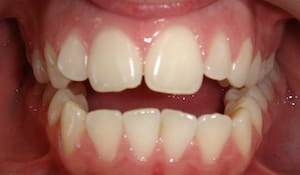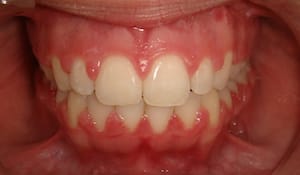Home - All About Braces - How to Know If You Need Braces - Open Bite

Erick practices orthodontics in our Riverton Oral Health office.
Open Bite
What an Open Bite Means—and How Braces Can Help.


An open bite is a type of malocclusion where the top and bottom front teeth don’t make contact when the mouth is closed. Instead of overlapping slightly like they should, the front teeth remain apart, leaving a visible gap even when biting down.
Open bites can affect appearance, speech, and oral function — and they typically don’t correct themselves without orthodontic treatment.
What Causes an Open Bite?
There are two main types of open bites: skeletal (jaw structure) and dental (tooth alignment). Causes may include:
- Prolonged thumb sucking or pacifier use
- Tongue thrusting when swallowing or speaking
- Genetics or jaw growth patterns
- Early or late loss of baby teeth
- Mouth breathing habits
When these factors interrupt normal jaw development, the upper and lower jaws may grow apart vertically instead of together, causing the open space.
Signs of an Open Bite
Parents might notice:
- A visible gap between the top and bottom front teeth when the mouth is closed
- Difficulty biting into foods like sandwiches or apples
- Speech issues (such as lisping)
- Tongue protrusion or pushing between teeth
- Excessive wear on back teeth from compensating
Some open bites are obvious in childhood, while others develop over time or worsen with growth.
Why Early Treatment Matters
- Difficulty chewing certain foods
- Speech difficulties
- Tongue thrusting or mouth breathing
- Jaw pain or joint strain
- Lower self-confidence in teens or adults
How Is an Open Bite Treated?
- Habit intervention therapy (for thumb sucking or tongue thrust)
- Braces or clear aligners to guide tooth movement
- Bite blocks or special appliances to modify jaw growth
- Jaw surgery (in severe adult skeletal cases)
When to See an Orthodontist
If your child’s front teeth don’t meet when they close their mouth, or if they struggle to bite or speak clearly, it may be time for a consultation.
Ready to get expert help for your child’s bite? Schedule your free consultation today — no referral needed. Learn more about how braces can help or schedule your complimentary consultation.
Claim Your Complimentary Consultation
Our orthodontic team is here to help with complimentary orthodontic consultations in Bluffdale, Riverton, Stansbury Park, and West Jordan.
Complete the form below or call (801) 254-9700 to schedule.
Frequently Asked Questions
Is it normal for front teeth to not touch?
Can thumb sucking really cause an open bite?
Is an open bite treatable with Invisalign?
In some cases, yes — clear aligners can close mild to moderate open bites, particularly in teens and adults. Severe cases may require braces or other interventions.